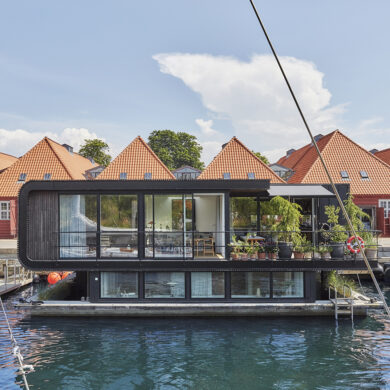A café experience with clean lines and furniture icons
In the café at the newly renovated Designmuseum Danmark in central Copenhagen, a six-metre-long counter from Garde Hvalsøe in raw steel and oak has found a natural home among furniture icons and other design classics. The refurbishment of the café was undertaken by OEO Studio with respect for Kaare Klint’s legacy and the original building conversion in the 1920s and a clear emphasis on design and durable materials.
Details
Case
Type
Model
Material


‘The starting point of our design of the café and the museum shop was to honour Klint’s work while also creating new, exciting and highly functional public spaces at the museum.’
In connection with the comprehensive renovation of Designmuseum Danmark in 2020–22, OEO Studio was entrusted with the task of updating the museum’s café and shop. The result is as harmonious and elegant as it is respectful of the historical setting of OEO founders Thomas Lykke and Anne-Marie Buemann’s updated spatial and interior design.
‘Known as the father of modern Danish furniture design, architect Kaare Klint pursued a style that was epitomized by clean, honest lines, superior materials and superb craftsmanship,’ says Thomas Lykke. ‘We were inspired by Klint and his almost ascetic design expression – subtle yet majestic.’
In the 1920s, Kaare Klint worked with architect Ivar Bentsen to transform this remarkable rococo building from its former role as a hospital to a museum with magnificent collections of crafts, applied art and furniture design that continues to attract visitors from all over the world. On any given day, you can hear many different languages spoken in the oblong, high-ceilinged space of the FORMAT café.
As a central feature of the lively space and diverse assembly of design chairs, which tell the story of Danish furniture design, the monumental café counter from Garde Hvalsøe offers a calm counterbalance. Based on Garde Hvalsøe’s OEO model, the counter was modified by OEO Studio in collaboration with Garde Hvalsøe to accommodate the functional requirements of a café environment and the context of this grand space that still shows Klint’s influence.
‘The starting point of our design of the café and the museum shop was to honour Klint’s work while also creating new, exciting and highly functional public spaces at the museum,’ says Thomas Lykke. The café counter pays homage to the sublime craftsmanship and Danish furniture culture that Klint and other leading furniture designers helped shape. This historical influence is combined with influences from Japanese design, which has been a consistent source of inspiration to OEO Studio for decades. The café counter’s vertical slats in solid oak are complemented by panels and a countertop in raw steel, a beautiful industrial material that is also used for the bars separating the wooden panels. The result is a tightly composed yet vibrant design that enters into a symbiotic relationship with Klint’s sense of clean lines and proportions and his love of quality materials.


‘We defined a material palette that complemented the building and the architecture. Materials of high durability and quality in a mix of hard and softer, warmer materials, including steel, wood, leather, stone and textiles.’
‘We defined a material palette that complemented the building and the architecture. Materials of high durability and quality in a mix of hard and softer, warmer materials, including steel, wood, leather, stone and textiles,’ says Thomas Lykke.
A core focus of OEO Studio’s spatial design is materials and design solutions that age gracefully and will stand up to many years of use. The monumental café counter sets the tone in the 240-square-metre room by introducing wood and raw steel as the primary material apart from the stone floor, which reuses the original stone tiles. Wood plays the lead role in many of the chairs in different wood types, shapes and colours in the café, while the large arched doors, which date back to Klint’s time and lead into the café kitchen, are clad with raw steel. Both wood and raw steel develop natural patina over time and form a beautiful contrast to both the stone flooring and the old, plastered walls, which have been repainted in their original colour. A large number of Kaare Klint’s iconic Fruit Lantern (1944) float under the ceiling, and just as the café counter draws on Denmark’s furniture design heritage, the past is also reflected in OEO Studio’s bespoke design of a new pleated lamp for FORMAT.
Throughout the museum – in its collections, exhibitions and research – past and present engage in dialogue with an eye to the future. In the café interior, OEO Studio combines design classics and new bespoke designs with the café counter as the central feature. Visitors can have lunch or a cup of coffee in the beautiful historical setting, perhaps even a sweet treat from the elegant display in glass and finger-jointed oak, itself a Garde Hvalsøe design that is given pride of place on the countertop.












